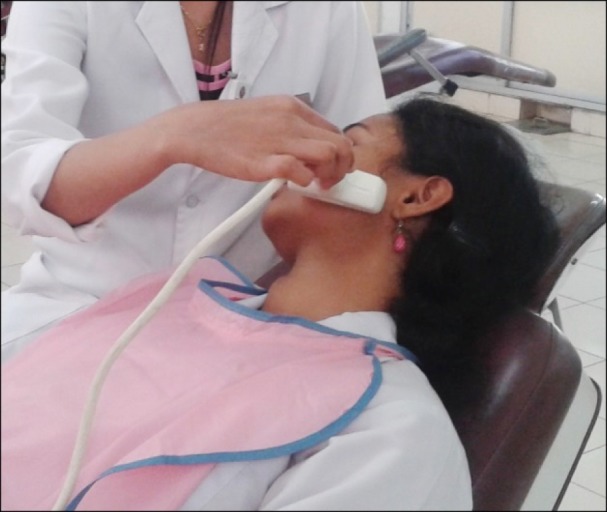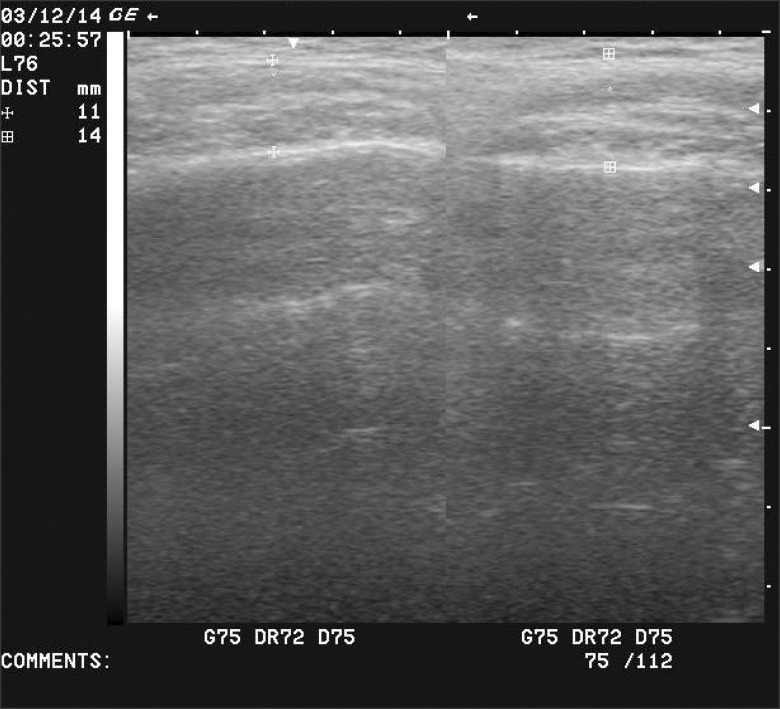Korean J Pain.
2016 Jan;29(1):12-17. 10.3344/kjp.2016.29.1.12.
Evaluation of Efficacy of Ultrasonography in the Assessment of Transcutaneous Electrical Nerve Stimulation in Subjects with Myositis and Myofascial Pain
- Affiliations
-
- 1Department of Oral Medicine and Radiology, D A P M R V Dental College, Bangalore, India. kotni.ramya@gmail.com
- KMID: 2151654
- DOI: http://doi.org/10.3344/kjp.2016.29.1.12
Abstract
- BACKGROUND
The study aimed to determine if ultrasonography of masseter can be used to evaluate the outcome of transcutaneous electrical nerve stimulation (TENS) in subjects with temporomandibular disorders (TMDs) such as myositis and myofascial pain.
METHODS
Fifteen TMD subjects with myofascial pain/myositis who satisfied the RDC/McNeil criteria were included in the study. All the subjects were administered TENS therapy for a period of 6 days (30 minutes per session). The mouth opening (in millimeters) and severity of pain (visual analogue scale score) and ultrasonographic thickness of the masseter (in millimeters) in the region of trigger/tender areas was assessed in all the subjects both prior and post TENS therapy. A comparison of the pre-treatment and post-treatment values of the VAS score, mouth opening and masseter thickness was done with the help of a t-test.
RESULTS
There was a significant reduction in the thickness of masseter muscle (P = 0.028) and VAS scores (P < 0.001) post TENS therapy. There was also a significant improvement in the mouth opening (P = 0.011) post TENS therapy.
CONCLUSIONS
In the present study, ultrasonography was found to be an effective measuring tool in the assessment of TENS therapy in subjects with myositis and myofascial pain.
Keyword
MeSH Terms
Figure
Reference
-
1. Grossmann E, Tambara JS, Grossmann TK, de Siqueira JT. Transcutaneous electrical nerve stimulation for temporomandibular joint disorder. Rev Dor São Paulo. 2012; 13:271–276.2. Blasberg B, Greenberg MS. Temporomandibular disorders. In : Greenberg MS, Glick M, Ship JA, editors. Burket's oral medicine. 11th ed. Hamilton: BC Decker Inc;2008. p. 223–256.3. Ariji Y, Sakuma S, Izumi M, Sasaki J, Kurita K, Ogi N, et al. Ultrasonographic features of the masseter muscle in female patients with temporomandibular disorder associated with myofascial pain. Oral Surg Oral Med Oral Pathol Oral Radiol Endod. 2004; 98:337–341. PMID: 15356473.
Article4. Rajendran R. Diseases of nerves and muscles. In : Rajendran R, Sivapathasundharam B, editors. Shafer's textbook of oral pathology. 6th ed. Gurgaon: Reed Elsevier India Private Limited;2009. p. 844–860.5. Ariji Y, Katsumata A, Hiraiwa Y, Izumi M, Sakuma S, Shimizu M, et al. Masseter muscle sonographic features as indices for evaluating efficacy of massage treatment. Oral Surg Oral Med Oral Pathol Oral Radiol Endod. 2010; 110:517–526. PMID: 20868996.
Article6. Moger G, Shashikanth MC, Sunil MK, Shambulingappa P. Transcutaneous electrical nerve stimulation therapy in temporomandibular disorder: a clinical study. J Indian Acad Oral Med Radiol. 2011; 23:46–50.
Article7. Rodrigues D, Siriani AO, Bérzin F. Effect of conventional TENS on pain and electromyographic activity of masticatory muscles in TMD patients. Braz Oral Res. 2004; 18:290–295. PMID: 16089258.
Article8. Kato MT, Kogawa EM, Santos CN, Conti PC. TENS and low-level laser therapy in the management of temporomandibular disorders. J Appl Oral Sci. 2006; 14:130–135. PMID: 19089044.
Article9. Kogawa EM, Kato MT, Santos CN, Conti PC. Evaluation of the efficacy of low-level laser therapy (LLLT) and the microelectric neurostimulation (MENS) in the treatment of myogenic temporomandibular disorders: a randomized clinical trial. J Appl Oral Sci. 2005; 13:280–285. PMID: 20878031.
Article10. Zuim PR, Garcia AR, Turcio KH, Hamata MM. Evaluation of microcurrent electrical nerve stimulation (MENS) effectiveness on muscle pain in temporomandibular disorders patients. J Appl Oral Sci. 2006; 14:61–66. PMID: 19089032.
Article11. Aldemir K, Üstüner E, Erdem E, Demiralp AS, Oztuna D. Ultrasound evaluation of masseter muscle changes in stabilization splint treatment of myofascial type painful temporomandibular diseases. Oral Surg Oral Med Oral Pathol Oral Radiol. 2013; 116:377–383. PMID: 23953424.
Article12. Bakke M, Tuxen A, Vilmann P, Jensen BR, Vilmann A, Toft M. Ultrasound image of human masseter muscle related to bite force, electromyography, facial morphology, and occlusal factors. Scand J Dent Res. 1992; 100:164–171. PMID: 1631486.
Article13. Okeson JP. Functional anatomy and biomechanics of the masticatory system. In : Okeson JP, editor. Management of temporomandibular disorders and occlusion. 6th ed. St. Louis (MO): Mosby Elsevier;2008. p. 2–24.
- Full Text Links
- Actions
-
Cited
- CITED
-
- Close
- Share
- Similar articles
-
- Effects of Electrical Stimulation of Transcutaneous Electrical Nerve and Acupuncture Stimulation in Patients with Myofascial Pain Syndrome
- The Effect of Transcutaneous Electrical Nerve Stimulation and Microcurrent on the Electrodiagnostic Study
- Effect of Repetitive Magnetic Stimulation and Transcutaneous Electrical Nerve Stimulation in Chronic Low Back Pain: A Pilot Study
- Pain relief during labor by transcutaneous electrical nerve stimulation
- Analgesic effect of transcutaneous electrical nerve stimulation on cold-induced pain



